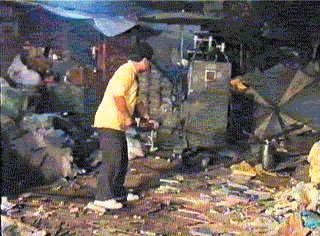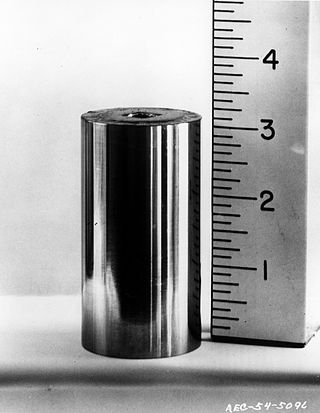A dirty bomb or radiological dispersal device is a radiological weapon that combines radioactive material with conventional explosives. The purpose of the weapon is to contaminate the area around the dispersal agent/conventional explosion with radioactive material, serving primarily as an area denial device against civilians. It is not to be confused with a nuclear explosion, such as a fission bomb, which produces blast effects far in excess of what is achievable by the use of conventional explosives. Unlike the cloud of radiation from a typical fission bomb, a dirty bomb's radiation can be dispersed only within a few hundred meters or a few miles of the explosion.
A cobalt bomb is a type of "salted bomb": a nuclear weapon designed to produce enhanced amounts of radioactive fallout, intended to contaminate a large area with radioactive material, potentially for the purpose of radiological warfare, mutual assured destruction or as doomsday devices. There is no firm evidence that such a device has ever been built or tested.

Acute radiation syndrome (ARS), also known as radiation sickness or radiation poisoning, is a collection of health effects that are caused by being exposed to high amounts of ionizing radiation in a short period of time. Symptoms can start within an hour of exposure, and can last for several months. Early symptoms are usually nausea, vomiting and loss of appetite. In the following hours or weeks, initial symptoms may appear to improve, before the development of additional symptoms, after which either recovery or death follow.

Radiological warfare is any form of warfare involving deliberate radiation poisoning or contamination of an area with radiological sources.

A nuclear and radiation accident is defined by the International Atomic Energy Agency (IAEA) as "an event that has led to significant consequences to people, the environment or the facility." Examples include lethal effects to individuals, large radioactivity release to the environment, or a reactor core melt. The prime example of a "major nuclear accident" is one in which a reactor core is damaged and significant amounts of radioactive isotopes are released, such as in the Chernobyl disaster in 1986 and Fukushima nuclear disaster in 2011.

The Goiânia accident was a radioactive contamination accident that occurred on September 13, 1987, in Goiânia, Goiás, Brazil, after an unsecured radiotherapy source was stolen from an abandoned hospital site in the city. It was subsequently handled by many people, resulting in four deaths. About 112,000 people were examined for radioactive contamination and 249 of them were found to have been contaminated.

Neutron activation is the process in which neutron radiation induces radioactivity in materials, and occurs when atomic nuclei capture free neutrons, becoming heavier and entering excited states. The excited nucleus decays immediately by emitting gamma rays, or particles such as beta particles, alpha particles, fission products, and neutrons. Thus, the process of neutron capture, even after any intermediate decay, often results in the formation of an unstable activation product. Such radioactive nuclei can exhibit half-lives ranging from small fractions of a second to many years.
Harold Elford Johns was a Canadian medical physicist, noted for his extensive contributions to the use of ionizing radiation to treat cancer.

Cobalt-60 (60Co) is a synthetic radioactive isotope of cobalt with a half-life of 5.2714 years. It is produced artificially in nuclear reactors. Deliberate industrial production depends on neutron activation of bulk samples of the monoisotopic and mononuclidic cobalt isotope 59
Co
. Measurable quantities are also produced as a by-product of typical nuclear power plant operation and may be detected externally when leaks occur. In the latter case the incidentally produced 60
Co
is largely the result of multiple stages of neutron activation of iron isotopes in the reactor's steel structures via the creation of its 59
Co
precursor. The simplest case of the latter would result from the activation of 58
Fe
. 60
Co
undergoes beta decay to the stable isotope nickel-60. The activated cobalt nucleus emits two gamma rays with energies of 1.17 and 1.33 MeV, hence the overall equation of the nuclear reaction is: 59
27Co
+ n → 60
27Co
→ 60
28Ni
+ e− + 2 γ
Radioactive scrap metal is created when radioactive material enters the metal recycling process and contaminates scrap metal.
The 1990 Clinic of Zaragoza radiotherapy accident was a radiological accident that occurred from 10 to 20 December 1990, at University Clinic Hospital Lozano Blesa of Zaragoza, in Aragon, Spain.

Between March and July 1962, a radiation incident in Mexico City occurred when a ten-year-old boy took home an industrial radiography source that was not contained in its proper shielding. Five individuals received significant overdoses of radiation from the 200-gigabecquerel cobalt-60 capsule, four of whom died.

These are lists of nuclear disasters and radioactive incidents.

A radiation accident occurred in Samut Prakan Province, Thailand in January–February 2000. The accident happened when an insecurely stored unlicensed cobalt-60 radiation source was recovered by scrap metal collectors who, together with a scrapyard worker, subsequently dismantled the container, unknowingly exposing themselves and others nearby to ionizing radiation. Over the following weeks, those exposed developed symptoms of radiation sickness and eventually sought medical attention. The Office of Atomic Energy for Peace (OAEP), Thailand's nuclear regulatory agency, was notified when doctors came to suspect radiation injury, some 17 days after the initial exposure. The OAEP sent an emergency response team to locate and contain the radiation source, which was estimated to have an activity of 15.7 terabecquerels (420 Ci), and was eventually traced to its owner. Investigations found failure to ensure secure storage of the radiation source to be the root cause of the accident, which resulted in ten people being hospitalized for radiation injury, three of whom died, as well as the potentially significant exposure of 1,872 people.

A radioactive source is a known quantity of a radionuclide which emits ionizing radiation, typically one or more of the radiation types gamma rays, alpha particles, beta particles, and neutron radiation.
A radioactive contamination incident occurred in 1984 in Ciudad Juárez, Mexico, originating from a radiation therapy unit illegally purchased by a private medical company and subsequently dismantled for lack of personnel to operate it. The radioactive material, cobalt-60, ended up in a junkyard, where it was sold to foundries that inadvertently melted it with other metals and produced about 6,000 tons of contaminated rebar. These were distributed in 17 Mexican states and several cities in the United States. It is estimated that 4,000 people were exposed to radiation as a result of this incident.










